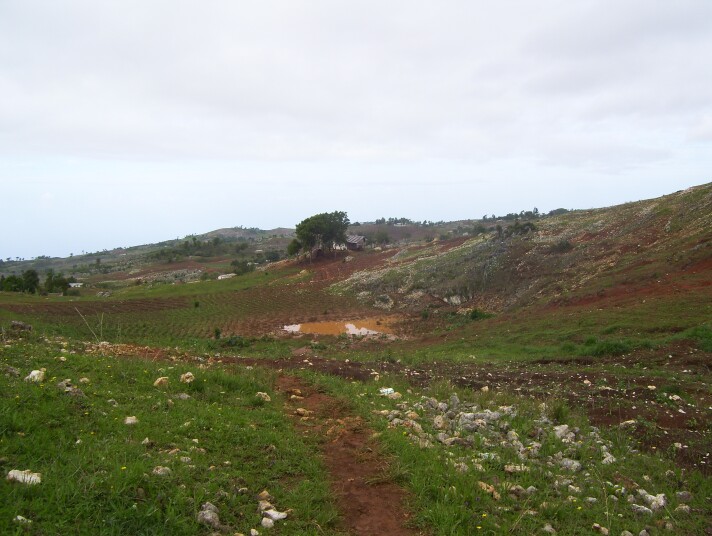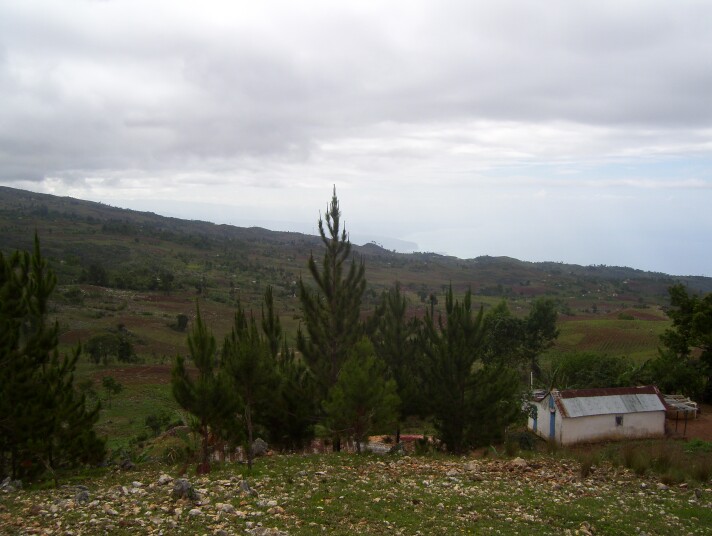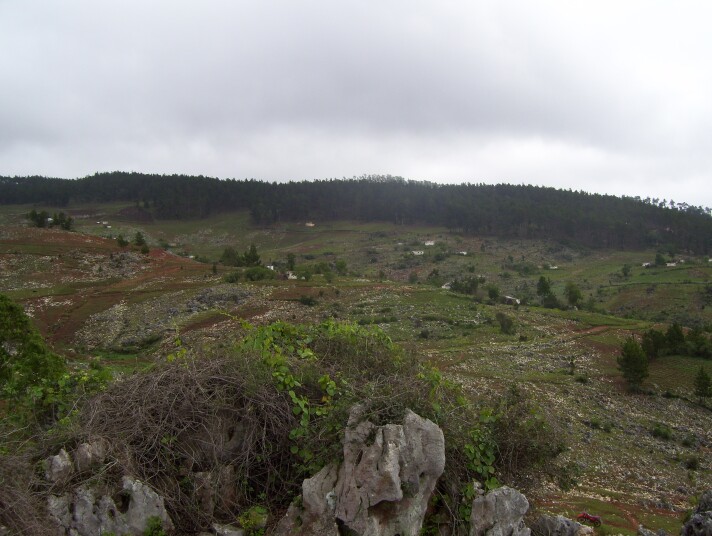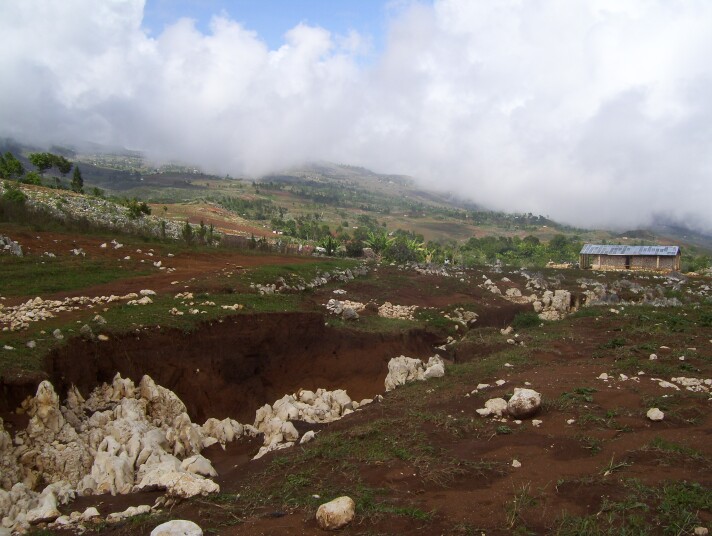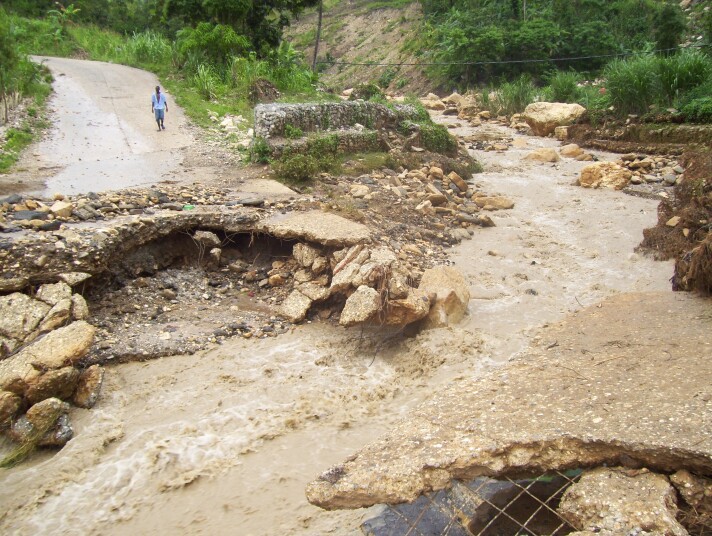The first sign that something was decidedly right about the credit center in Mablanch was evident the moment we arrived.
Mablanch is one of the most distant centers that our Marigo office serves. It’s an extremely rural, agricultural region in the mountains overlooking Belans, the isolated coastal town to the east of Marigo. A fast motorcycle needs about 90 minutes to get to the path that turns off from the main road to head up to Mablanch. The path is steep, winding, and rocky. A lesser driver than Moïse, the credit agent I accompanied, would be in for trouble. As it is, the cycle slipped out from under us a couple of times – there’s been a lot of rain – but Moïse was up to the challenge.
It is also the strongest of the Marigo branch’s nearly forty credit centers. It has about seven solidarity groups, and a little over thirty members. The members there are 100% up-to-date with their repayments, and center meeting attendance is, if not perfect, at least very good.
When we got Mablanch, the women who belong to the center had already gathered on the patio where the meeting was going to take place. There were a half-dozen assorted men and boys on the patio as well, chatting with the women and with each other. But the minute Moïse and I showed up, the women sent the men away. A few of the older men left immediately, without being told. Then the women politely but firmly told the others they’d have to go. These women were distinctly in charge of their center.
Fonkoze works towards developing the necessary underpinnings of a democratic economy in Haiti. That means providing the poor with the financial services – and other accompanying services – they need to improve their own livelihoods. But a crucial aspect of Fonkoze’s mission is that it works especially with and for Haiti’s women.
We often explain this by saying that, in typical Haitian households, especially in poor households, women end up with an ultimate responsibility for seeing their children clothed, fed, educated, and otherwise cared for. Many households have men that contribute, even significantly, but typical Haitian gender roles leave women with some money in their hands – whether they earn it through their own work or receive it from their partner – and the responsibility to turn that money into all that their family needs. So, Fonkoze can support the progress of whole families most directly by dealing with women.
But that’s only part of the story. In Haiti, as elsewhere, women live with men on very unequal terms. This is, in part, a consequence of Haiti’s poverty, but it is also a cause.
Fonkoze has learned a lot about this, for example, from its experience with the poorest of the poor, whom it serves with Chemen Lavi Miyò, an 18-month program designed especially to combat extreme poverty. The women in that program start with no income-generating assets of any kind – no land, no goats, no chickens, no small commerce – and are living on as little as 50 cents per day. It is not unusual for them to have seven, eight, or nine children, acquired with multiple different fathers, because they have sought, by joining themselves to one man after another, to find someone who’ll help them support their kids. Instead of support, they end up with additional children to fend for on their own, and their poverty only intensifies.
Even less extreme examples are striking enough. I attended a ceremony held in Boukankare for women who were graduating from Fonkoze’s Ti Kredi program, the one designed for those better off than Chemen Lavi Miyò members, but not strong enough to enter into standard solidarity-group credit.
The main speaker was one of the graduates, and you can find her speech on youtube.
http://youtu.be/otfP4yzSEOw
Her central message is clear: Women love Fonkoze for helping them escape the humiliation they are subject to in their lives with men.
So a second reason Fonkoze has for prioritizing women in its work is that the world, and Haiti within it, is sexist, and justice requires that women are able to establish their own independent sources of income.
But it’s not easy. There is no easy way, for example, for me to replace Moïse with a woman to work with the credit centers he serves. The Marigo branch can count itself fortunate to have one woman on staff who rides a motorcycle well and can get to the least accessible credit centers to work with members. Her name is Judithe, and she supervises Fonkoze’s educational programs for us. But such women are hard to find in Haiti. So though our tellers are women, all our credit agents are men. Fonkoze has very few women credit agents at its 40 offices throughout Haiti.
And when Moïse arrives at even a strong credit center like the one in Mablanch, they treat him with all the traditional gestures of respect we show for those we view as more important than ourselves, even though there are those among the women more than old enough to be the twenty-something Moïse’s mother. He sits in a comfortable chair, while they sit on benches or stones walls. They call him “ajan”, or agent, turning his job title into a title of respect. They tell one another to shut up whenever he opens his mouth. It’s a problem that we will have to fight to overcome.
But if only it was the only problem of domination by men that we face, we be in pretty good shape. Though it’s probably the most pervasive form of domination we see, it might be the least grave.
I recently wrote of a man I called Jean. He attends meetings at a center in the Belè neighborhood of Segen, making repayments for his two daughters, who have loans in their names. It is now clear that the girls never had access to credit at all, that they don’t even have businesses, but that their father was simply using their names to gain access to credit he’s not entitled to. At the last Belè meeting he informed me that he would be withdrawing his girls from the credit program at the end of their current loan, and he spent a lot of time going over and over his reasons. When some of the women at the meeting asked him to leave so that they could take care of their business, he blew up at them. He informed them that they have no right to tell him to leave, that he in fact can tell them to leave because he has a position of authority in the church that let’s the women meet in its building. And for all I know, he can just cut of access to the space whenever he wants. Most of the women, in any case, seemed to feel they had to put up with his boorishness, even if they complained to me about it once he finally did leave.
And Jean is by no means the worst of the worst. On Wednesday, I visited a very remote center in an area called Kajak. Kajak is high in the mountains, beyond Segen, at the entrance to one of Haiti’s national forests. The women who belong to that center walk hours to get there. Many of them live closer to Pétion-Ville, on the other side of the mountain, than they do to Marigo. Most sell produce in the markets in Kenscoff, Pétion-Ville, and Port au Prince, with side businesses in the little rural markets near their homes.
Their credit center was established by Fonkoze with the help of a community leader named Dickenson. He introduced the women to Fonkoze’s credit agent, and that’s where his participation, his leadership, should have stopped.
But the reality is that he is much closer to the women than Fonkoze can hope to be, and he has used that fact to his own profit.
We spoke with a couple of dozen of the women at length on Wednesday, and learned that Dickenson had been assessing them various fees in exchange for their participation in Fonkoze. They paid him a registration fee and a fee for each new loan they received. Those who came to Marigo to receive hurricane credit, who needed help badly enough to make the long and expensive trip, had to deal with Dickenson first. He arranged transportation – for a high fee. He served them a meal on the way – an expensive one. And he charged them a fixed price for the credit Fonkoze gave them. We knew none of this at the time.
What’s worse, he began actually collecting reimbursements, promising to turn the money over to Fonkoze. And the money remained in his hands. So, many of the women are carrying debt that they believe they’ve paid.
It’s a mess. If we can straighten it out at all, it’s going to take time. And even if we recuperate some of our losses, it is unclear whether we can continue to serve these women, as badly as they need us, because we don’t know how to prevent a scoundrel like Dickenson from preying on them and us.
But helping women take control must remain a priority, even if we consider only our own operation. It is surely no coincidence that the best-functioning credit center we have in Marigo is the one in Mablanch, where the women have the largest measure of control.
I try not to be naïve. There is more to the inequalities that women suffer every day than the unequal economic conditions that structure their lives. But helping women develop their own income stream seems like a necessary and significant first step in the right direction.

